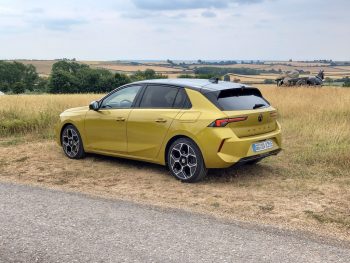First Drive: Vauxhall Astra Plug-in Hybrid-e
The number of derivatives and powertrain options might have changed but, after 40 years, the Astra still hits the spot.

The new Plug-in Hybrid-e marks the first time an Astra model has been available, from launch, with an electrified powertrain
WHAT IS IT? PHEV Hatchback
HOW MUCH? From £32,700
RANGE? 43 miles
How long to charge? 1 hour 55 mins (7kW wallbox or public charger)
It’s fair to say the Vauxhall brand has been on a bit of a journey over the past five years. Now safely ensconced under the Stellantis umbrella it is thriving, having joined the family there in 2021 from Groupe PSA who, in turn, had bought the brand from General Motors. In fact, as the wraps are taken off the eighth-generation Astra, Vauxhall finds itself the number one marque within the entire Stellantis group, with year-to-date sales for the first half of 2022 of 63,457 units. Electrified versions of the Corsa and Mokka are leading the charge and, as James Taylor, acting MD of Vauxhall and UK B2B director of Stellantis, puts it: “Where we’ve got vehicles that are electric, we’re dominating the market.”
As a result, Taylor and his colleagues will be hoping for more of the same from the Plug-in Hybrid-e, the first time an Astra model has been available, from launch, with an electrified powertrain. All-electric models are set to arrive next year but, for now, those drivers looking for an ICE alternative Astra (although petrol and diesel Astra models are available) have an option.

There’s a new look inside and outside
The new Astra PHEV sits on the adaptable EMP2 platform, which caters for all powertrain types and is also the basis for the new Peugeot 308. The full powertrain complement in the Hybrid-e is a 1.6-litre turbo petrol engine and a 110hp electric motor – electric power comes from a 12.4kWh lithium-ion battery. Combined, there is 180hp on tap and maximum torque of 250Nm. That’s enough for a zero to 60mph time of 7.7 seconds and fuel consumption of 256mpg (WLTP). In all-electric mode, the Astra Hybrid-e offers a theoretical 43-mile driving range (WLTP, EAER). It also enables CO2 levels of 24g/km, meaning it meets the requirements for a BiK rate of 8% (based on the 2022/2023 targets). While our test drive didn’t quite hit the 43 miles, we weren’t far off, with high thirties being achieved before the engine kicked in. Charging-wise the battery can be replenished in as little as under two hours, when using a 7kW wallbox or public charger. For domestic plugs, it’s more like 5.5 hours.
There’s a new look inside and outside, with the design message for Astra being ‘Bold and Pure’, according to the company. New Astra inherits Vauxhall’s ‘Vizor’ front-end with new Griffin logo and, interestingly, front air vents that are inspired by a motorcyclist’s helmet!
Inside the car, there’s a new steering wheel design, AGR-certified seats and a sensible selection of physical buttons, alongside the more modern touchscreen and voice control options. The ‘driver-focused’ interior is epitomised by the Pure Panel digital interface, which includes two 10-inch screens that are customisable. Keenly aware of the reliance of touchscreen menus, Vauxhall has added a thumb rest under the 10-inch central digital touchscreen to make menu navigation more comfortable.
Dynamically, the car has also been driver-focused, with specific fine tuning on the steering and braking systems. Astra uses the third version of the EMP2 platform, where half of the parts have been replaced or upgraded – for example, power steering, shock absorbers and springs. The result is a more dynamic and responsive car than the outgoing model or many others in its class. The handling has been improved thanks to a 14% improvement in body stiffness, while NVH performance is noticeably better, in large part thanks to new glass and door seals.
Another change with the new Astra range is a contraction in the number of derivatives available – from 362 to just 54. This reduction doesn’t affect the quality, however, with three grades available to drivers: Design, GS Line and Ultimate. However, the PHEV is only available in GS Line – expected to be the most popular seller – and Ultimate.
Which model is right for you?
The new Astra is very generously specified with a number of standard features you might not expect in this segment. For example, there’s Vauxhall’s Pure Panel sat-nav system, displayed via those dual 10-inch screens as well as cruise control and LEDs all round.
Drivers choosing a GS Line Astra – most likely to be the most popular – will have traffic sign recognition, a 360° panoramic camera and heated steering wheel and front seats.
Move up to the top-spec Ultimate models and Vauxhall has added in features such as IntelliLux LED headlights, an eight-speaker sound system, wireless charging and dual-zone climate control.
The Lowdown
Vauxhall Astra PHEV
Key fleet model: Plug-in Hybrid-e GS Line 180hp
Thumbs up: Performance, refinement, interior quality
Thumbs down: Ride quality, limited rear space
Seven-word summary: A hatchback ready for the electrified future
Also consider: Ford Focus, Peugeot 308, Volkswagen Golf












